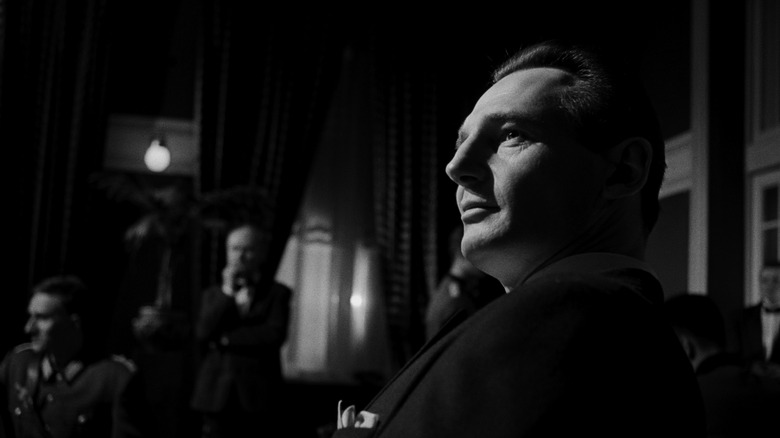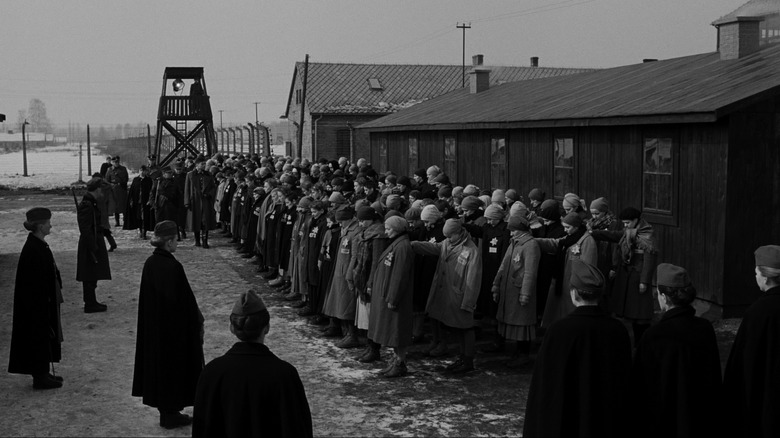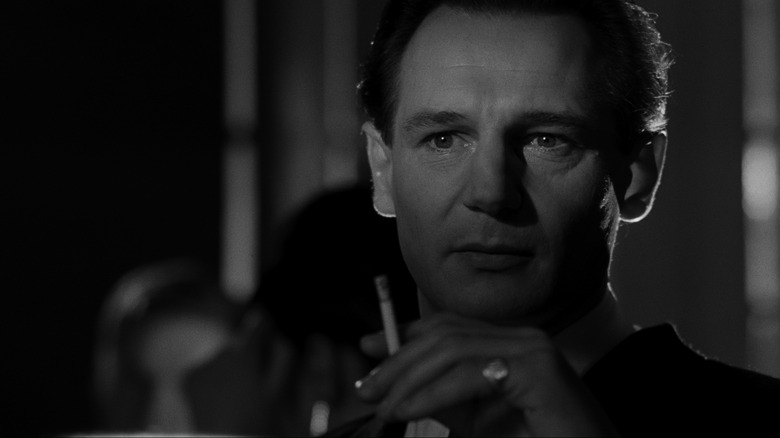Why Liam Neeson 'Lost It' Before Shooting His First Scene For Schindler's List
Steven Spielberg's 1993 Holocaust drama "Schindler's List" is a harrowing experience just to watch, so one can only imagine what it was like filming it. The film is based on the true story of Oskar Schindler, a German industrialist and businessman who helped save the lives of more than a thousand refugees from the Holocaust. He would employ the mostly Polish-Jewish refugees in his factories throughout the war, which gave them protection as industrial workers. These saved refugees would go on to be called the Schindlerjuden, and their story would be shared with the world in the 1982 novel "Schindler's Ark" by Thomas Keneally. "Schindler's Ark" formed the basis for "Schindler's List," which starred Liam Neeson as Schindler, bringing the horrors of the Holocaust to life in stark black and white.
"Schindler's List" became an instant classic, winning seven Academy Awards including one for Best Picture and another for Best Director. While there is hope in the film because of Schindler's efforts, it's also a brutal look at how terrifying it was to be Jewish when it could very easily end up being a death sentence. That reality became crystal clear to Neeson just before filming his first scene, and it hit him something fierce.
The moment when Neeson 'lost it'
In an oral history of the film for The Hollywood Reporter, Neeson revealed that his first scene was filmed at the gates of Auschwitz, where he had a conversation with one of the film's co-producers, Branko Lustig. Lustig had survived his time at Auschwitz and even pitched his qualifications by rolling up his sleeve and showing off his identification number tattoo. So, when he started sharing some of his experiences, Neeson was truly shaken:
"Before my first scene, we were at the gates of Auschwitz. I was walking outside the barbed wire, waiting to be called to set. I had my Schindler stuff on, a big fur-lined coat, and I was a little nervous, looking at the huts inside Auschwitz. Branko sidled up beside me and said, 'How do you feel?' I said, 'I feel OK. It's an intense scene, and it'll be good to get it under my belt.' Branko casually pointed to a hut and said, 'See that hut there, second from the left?' I said, 'Yeah.' He said, 'That's where I was.' F***, I just lost it. He was there at the age of 6. Two years he spent there. I remember my knees weakened, and I thought, 'You've got to pull yourself together, man. This isn't acting in just another movie.'"
Not only was Neeson hit with the weight of trying to get the story right, but because "Schindler's List" was filmed on location, he was also hit with the history of the very ground on which he stood.
The importance of getting Schindler right
While the real story of Oskar Schindler is a bit more complicated than the sheer heroics of Spielberg's film, he needed to be a hero in the movie to help balance the true-to-life horrors that the Jewish characters in the movie faced in order to make it a bit easier for audiences to process. The real focus of the movie isn't really Schindler anyway but instead serves to evoke empathy for both his workers and those refugees who weren't fortunate enough to find protection through him. It forces the audience to reckon with the tragedy of the Holocaust on both a global and personal scale. From Neeson's retelling of his experience, it sounds like it forced the people making the film to fully comprehend the scope of it all as well.
In the end, Neeson's Schindler is a man who was haunted by the things he saw, and who tried to help make some small dent in the evils of the world. Neeson probably drew from his own feelings of being haunted by the atrocity that took place in the very locations where he was filming. It couldn't have been easy working on "Schindler's List," but it is a vital film that should help remind us of the dangers of nationalism and bigotry, so we should be thankful to Spielberg, Neeson, Lustig, and the rest of the people who helped bring it to the big screen.


